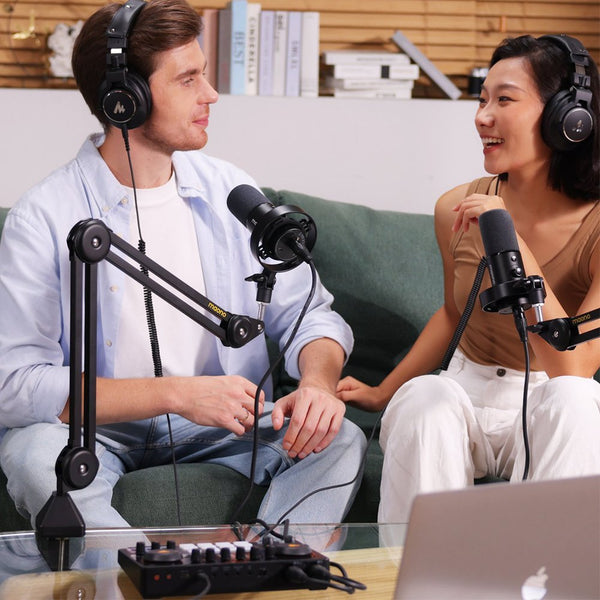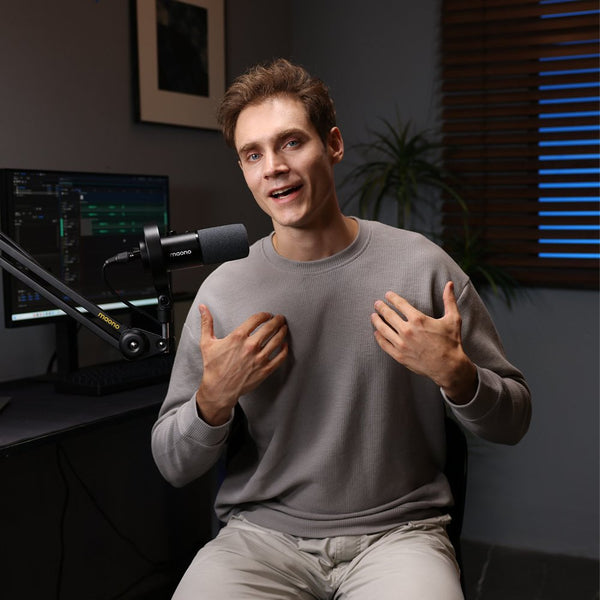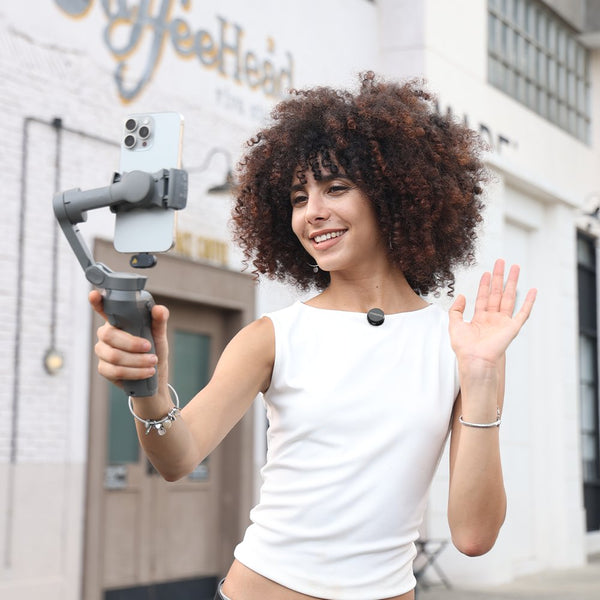Who would have thought that piano lessons could be done online back in the ’90s? Just recently—about six years ago—music instructors began proving that learning musical instruments virtually is not only possible but effective. Whether you're a music instructor or a student who wants to learn how to play the piano, both of you can benefit from using a condenser microphone to amplify your music. Let’s learn how.
Learning piano online has become more than just a trend—it’s now a widely accepted and accessible way for beginners and advanced students alike to develop musical skills. With flexible scheduling, access to global teachers, and user-friendly platforms, online piano lessons are proving just as effective as traditional, in-person instruction. However, sound quality plays a vital role in virtual learning success, which is why using a condenser microphone can significantly enhance the experience for both students and instructors.
In this article, we’ll walk you through what to expect in your first online piano lesson and explore how condenser microphones—like the Maono PM500 and Maono PM320 XLR—can take your virtual piano classes to the next level.
What to Expect from Your First Online Piano Lesson
Your first online piano lesson is typically focused on setting up a foundation: understanding the layout of the keyboard, learning how to sit properly, and identifying your current skill level. The teacher might ask you a few questions about your music background (if any), demonstrate a few simple exercises, and assess your ability to follow along. For total beginners, this will include basic music theory and hand placement.
You’ll also test out your tech setup, which includes your camera, keyboard or digital piano, and—ideally—a professional condenser microphone to ensure the best sound quality during the session.
How Online Piano Teachers Introduce Music Theory to Beginners
Online piano instructors begin with the basics of music theory to help students understand what they’re playing. You’ll likely cover:
-
The names of the keys (A–G)
-
The musical alphabet
-
Introduction to notes on the staff
-
Basic rhythms and note durations
-
Simple chords and intervals
Teachers use screen sharing, diagrams, and notation apps like Musictheory.net or Flat.io to visually reinforce these concepts.
Finger Placement and Posture: The First Online Piano Lesson Basics
Proper hand position is essential for technique and avoiding injury. Teachers often guide you to:
-
Curve your fingers naturally over the keys
-
Relax your wrists and shoulders
-
Keep your feet flat and back straight
Using a well-angled webcam or a second device (like a tablet or phone) for side or overhead views helps teachers observe your form. High-quality audio from condenser microphones ensures they also hear how pressure and placement affect your tone.
How Online Instructors Teach Piano Without Physical Contact
Without the ability to physically guide a student’s hands, online piano instructors rely on:
-
Demonstrations via video (often from multiple angles)
-
Verbal cues to correct position and rhythm
-
On-screen annotations on digital sheet music or keyboard apps
This method encourages students to become more self-aware and independent learners from the start.
Building Good Habits from Lesson One in Virtual Piano Classes
From day one, teachers emphasize consistency in posture, rhythm, and practice routines. You may receive:
-
Practice assignments and recordings
-
Videos to review during the week
-
Suggested apps like Simply Piano, Yousician, or Metronome+
Forming the right habits early, combined with real-time teacher feedback, lays a strong foundation for musical success—even in a virtual setting.
Piano Lessons FAQ:
What do piano instructors usually teach in the first online lesson?
Basic keyboard layout, simple music theory, and beginner finger exercises.
How do teachers assess a student’s skill level during a virtual piano class?
Through observation, short performance tasks, and questions about musical experience.
What basic skills do beginners learn first in online piano lessons?
Hand position, identifying keys, simple rhythm, note reading, and basic exercises.
How do instructors teach finger numbers and hand positioning virtually?
Using visual aids, demonstrations, and directing students to mimic hand shapes on camera.
Do you need to know how to read music before starting online piano lessons?
No. Most beginner lessons include step-by-step music reading instruction.
What tools or apps do online piano teachers often use?
Zoom, Musictheory.net, Metronome apps, and digital notation tools like Musescore.
Can children learn piano effectively through virtual lessons?
Yes—especially with engaging teachers, parental support, and structured practice plans.
How do teachers correct posture or technique remotely?
By using multiple camera angles and clear verbal cues, plus screenshots or playback videos.
How long should my first online piano lesson be?
Typically 30 to 60 minutes, depending on age and concentration span.
What kind of keyboard or piano is best for online lessons?
A full-size digital piano (88 keys) with weighted keys is ideal, but 61-key keyboards can work for beginners.
Condenser Microphone FAQ Section
Do music instructors recommend condenser microphones for online lessons?
Yes. Condenser mics offer greater sensitivity and clarity, ideal for capturing both piano dynamics and the teacher's voice.
Why condenser microphones are ideal for online piano lessons?
They pick up subtle nuances, from gentle keystrokes to dynamics in playing, allowing for better assessment and guidance.
What makes condenser mics better than built-in laptop microphones?
Built-in mics tend to compress sound and distort tone. Condenser mics capture rich audio detail and reduce background noise.
Do condenser microphones help piano students hear notes more clearly?
Absolutely. Clear sound helps students recognize note values, articulation, and volume—key factors in developing musical ears.
How does using a condenser mic help instructors give better feedback?
High-quality sound allows teachers to hear mistakes in touch, rhythm, or volume that would be missed with poor audio input.
Is a condenser microphone necessary for beginners taking virtual lessons?
While not required, using a recommended condenser microphone ensures clearer communication and better learning outcomes.
Recommended: Best Budget Condenser Microphones for Online Piano Lessons
Maono PM500 XLR Condenser Microphone

Best Features:
-
Studio-grade XLR mic connectivity for high-fidelity sound
-
Premium metal build with a large diaphragm for detailed vocal and instrument capture
-
Smooth frequency response (20Hz–20kHz) for full-spectrum sound
Why it’s great:
The Maono PM500 is a professional condenser microphone that delivers studio-level performance without breaking the bank. It’s excellent for recording both piano and vocal instruction clearly, making it ideal for teachers and learners alike.
Maono PM320 XLR Condenser Microphone

Best Features:
-
Wide dynamic range and high SPL for instrument recording
-
Low self-noise and cardioid pickup pattern to isolate piano sound
-
Comes with a shock mount, pop filter, and mic stand
Why it’s great:
The Maono PM320 is another recommended condenser microphone that balances price and quality perfectly. It’s especially effective for virtual piano instructors who need to capture both their playing and voice without interference or distortion. It’s an excellent choice for virtual piano instructors who need to sound clear while playing. It isolates the sound of your piano and voice beautifully, making it easier for students to follow instructions without distraction.
Can condenser mics capture both voice and piano well in one setup?
Yes. Both the PM500 and PM320 XLR microphone are designed to capture the full range of a piano and the nuances of speech simultaneously.
How do I connect a condenser microphone to Zoom?
If using an XLR mic, you'll need an audio interface (like the MaonoCaster AME2). Set your mic as the input device in Zoom’s settings.

What are common mistakes when using condenser mics for virtual teaching?
-
Placing the mic too far or too close to the sound source
-
Not using a pop filter (causing harsh "p" and "s" sounds)
-
Forgetting to set the mic as the input in Zoom or your audio interface
-
Ignoring room acoustics (hard surfaces can reflect unwanted echo)
Conclusion
Your first online piano lesson marks the beginning of an exciting and rewarding musical journey. With the right instructor, clear visual guidance, and strong practice habits, students of any age can thrive in a virtual learning environment.
However, don’t overlook the importance of sound quality. Using a professional condenser microphone, such as the Maono PM500 or PM320 XLR microphone, ensures you’re getting the best audio possible for real-time feedback. Pair it with a reliable audio interface, and you’ll have a setup that allows for exceptional clarity—helping you or your students grow musically with every note.
So tune your keyboard, set your camera, connect your XLR mic, and let the music begin—loud, clear, and beautifully detailed from anywhere in the world.
Related Article:



